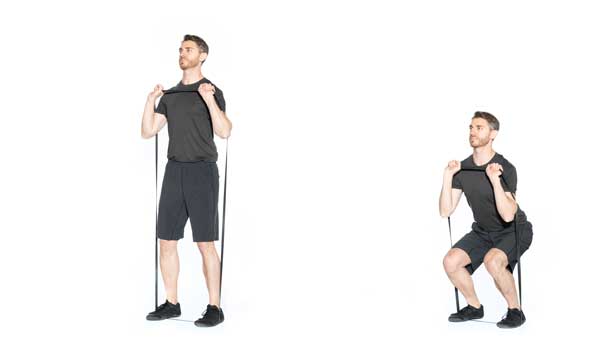Are you ready to take your home workouts to the next level? If you’ve recently been to a sporting goods store, a physio appointment or a gym like Club 16, you’ve probably seen multicoloured bands hanging around somewhere. Those are resistance bands, and while they might not look like a gym equipment heavy-hitter, they can pack a punch in any workout routine.
So what exactly are resistance bands for, and how can you use them to help you get in shape?
The benefits of resistance bands
Resistance bands are versatile, affordable and compact equipment, great for the gym beginner or the advanced workout warrior.
Practically speaking, resistance bands are inexpensive compared to free weights or machines. They also take up little to no storage space, so you can easily set up a home gym for yourself even when you’re tight on space.
They are travel-friendly, being light and easy to pack—making your workouts easy to do while on the road. Throw 3 or 4 different-sized bands in your luggage, and you can get a full body workout wherever you go. The key to starting an exercise routine and sticking with it is consistency, and vacations are notorious for bringing a new workout routine to a full stop.
Resistance bands come in various styles and thicknesses, from flat bands to handled tubes. The following are some ways that resistance bands can benefit your exercise routines:
- Warm-up and mobility work: Incorporate resistance bands with dynamic stretches to increase blood flow to muscles, mobilize your joints, and help reduce the risk of injury.
- Injury rehabilitation work: Resistance bands can strengthen movements with less impact on your joints, providing more eccentric contraction and improving joint stability.
- Build muscle: With resistance bands, you can do the same exercises you would with weights and machines to build muscle. Choose a thicker band to increase resistance, similar to increasing weight with dumbbells and barbells.
What to look for in a resistance band
There are many resistance band options, so what you buy depends on what you use them for. You want to look for rip-resistant bands with good online reviews if you’re buying online. And if possible, choose quality because cheap bands are cheap for a reason!
While a variety of light, medium and heavy bands is ideal, the following are some specific suggestions:
- Choose tube bands with handles if you are working with multiple muscle groups.
- Choose heavier resistance bands if your focus is on strength exercises.
- Choose lighter resistance bands if your focus is on endurance.
- Choose cloth bands for lower body exercises.
Tips to properly use resistance bands
Like free weights, good form is key to getting the most out of your resistance bands. Distribute your weight evenly throughout your body when doing exercises. Strong form using a light band will help you gain muscle faster than when you’re trying to push through using a heavier resistance band with poor form.
Your workout should be challenging but not impossible. You need the proper resistance for you; adjust your workout accordingly. Ensure your body is moving slowly and fluidly, without any jerking motions.
Aiming to work continuously for 20 to 60-second sets without slack on the band is ideal. After each rep, return to your resting position slowly and with control.
Most importantly, be safe! Resistance bands can snap back quickly if released under tension, which can lead to injury, so take your time releasing them after your sets.
How do you stop resistance bands from rolling up?
Having your bands roll up is a workout buzzkill. There are a few things you can do to keep the roll-up at bay:
- Instead of rubber, use fabric bands which grip easier and are less prone to rolling.
- Bands shouldn’t be too loose or tight—-find the one that fits just right to decrease the chance of roll-up.
- When using them for your legs, prioritize proper placement by putting the bands around your knees or 2-3 inches below.
Putting it into practice: A simple, full-body resistance band workout
The beauty of resistance bands is their versatility. These simple pieces of equipment can elevate all of your favourite, quick and easy exercises. Check out this simple full-body resistance band routine to get you started.

Squats
- Use a circular resistance band or one with handles.
- Using a light resistance band, step on the band with both feet shoulder-width apart.
- Hold onto the ends of the band with one hand on each side.
- With the majority of your weight in your heels, push your butt back and lower your body like you’re sitting in a chair.
- Push through your hips and stand back up.
Chest Press
- Use a resistance band with handles.
- Use an anchor point at about shoulder height (e.g., a pole or sturdy fence). You can also use a door anchor (like this one).
- Grab one handle in each hand and face away from the anchor point.
- Use a staggered stance and press the resistance band out in front of you until your arms are locked in full extension, and then return to the starting point.
- Check out this video of a chest press using a door anchor:
Bicep Curls
- Use an exercise band with handles.
- Stand on a resistance band with one foot, knees slightly bent.
- Tuck your elbows into your sides, activate your biceps muscles and pull the handles towards your shoulders.
- Pause for a second, then return to the starting point.
- Check out this video of how to do bicep curls with a resistance band:
Standing Back Row
- Use an exercise band with handles.
- Use an anchor point that is about chest height.
- Grab one handle in each hand and face away from the anchor point.
- Use a staggered stance with slightly bent knees and pull the resistance band towards your chest.
- Pause for a second, then return to the starting point.
- Check out this video of how to do a standing row:
Lateral Shoulder Raise
- Use an exercise band with handles.
- Stand on a resistance band with both feet, knees slightly bent.
- Hold your hands to your sides and raise your arms until they are parallel with the floor.
- Pause for a second, then return to the starting point.
- Check out this video of how to do a lateral shoulder raise:
Can resistance bands replace free weights?
It depends on your goal! Resistance bands and free weights both allow for a free range of motion, different movement speeds and resistance.
Resistance band work can lead to strength gain, but not to the degree that free weights do—free weight training is the best catalyst for muscle gain. While resistance bands can help you get stronger, there are only so many levels of bands available. Free weights provide a greater variety of sizes and difficulty levels.
However, if you’re not training to look like Arnold Schwarzenegger in the 70s, resistance bands can be a great substitute for free weights. Plus, they are cheaper and take up way less space.
What’s your favourite Arnold movie? Share in the comments below!


Let’s Talk!
Did you enjoy this article? Let us know in the comments.
0 Comments